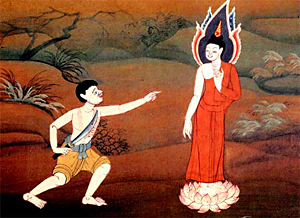
The British scholar of Buddhism Richard Gombrich has a seemingly endless supply of insightful readings of texts that we as Buddhists assume we know through and through. Take Angulimala (please).
The standard story is one of the most famous in all of Buddhism. A fierce robber and murderer named Angulimala cuts off the fingers of unwary travelers in his forest. He wants to get 1,000 fingers and already has 999 sewn together in a monstrous necklace (hence his name: anga, finger + mala, garland/necklace). Along comes the Buddha. Angulimala chases him and though the Buddha simply walks at a slow and stately pace and Angulimala runs as fast as he can, the villain can’t catch up. Amazed by this and by the Buddha’s calm in the face of danger, Angulimala renounces his evil ways and becomes a devoted Buddhist.
That much is well known, but Dr. Gombrich has a different read. We know Angulimala’s parents’ names, which mark them as brahmins. The commentary to the texts says that Angulimala was cutting off fingers (he is referred to as a robber but never steals anything other than fingers, and it isn’t clear that he necessarily kills his victims either) because his teacher in Taxila—the intellectual center of the Buddha’s time—forced him to. Still, a brahmin student seems an unlikely finger-cutter-offer. Gombrich reads a particular word, maheso, as a title of the god Siva, which is a common reading in brahmanic (but not Buddhist) literature, and so translates the famous quatrain where Angulimala announces his conversion in this way:
For a long time to fulfill a vow I have been honoring Siva. You have arrived in the forest, speaking truth. So I shall give up my thousand crimes, for I have heard your verse, which teaches what is right.
But how is Angulimala honoring Siva with his necklace of fingers? Gombrich identifies this as one of the earliest pieces of evidence for the practices known as tantra: “Tantra rests on the idea, which permeates the local traditions of south and southeast Asia, that a worshiper can somehow identify with his god in a literal sense…. The tantric… acts out this identification by adopting the deity’s iconic appearance, wearing his or her accoutrements.” By this formulation Angulimala should be considered more of a black magician taking on the appearance of a fierce emanation of Siva than a murderer or robber.
There are other examples of tantra in the Pali Canon as well, such as the monk known as Mahakala(!) who practices a charnel ground meditation/visualization based on devotion to the goddess Kali before his conversion to Buddhism. Gombrich writes:
I think we can safely say that for about a thousand years Buddhism in India was a religion which could be characterized as antithetical to tantra, or at least to Saiva/Sakta [Siva and Kali practice] tantra, which was the tantric religion par excellence…. There is perhaps a certain irony in the fact that somewhere around the time when Hiuen Tsiang [Chinese pilgrim who visited India in the 7th century CE] was under threat of being made a sacrificial victim—we cannot specifiy the date closer than by a couple of centuries—Buddhism was massively invaded by tantra, and the Vajrayana tradition was born. Both in depending on the practitioner’s identification with gods/demons, a sophisticated ideologisation of possession, and in drawing power from impurity, Buddhist tantra is paradoxical Buddhism and has turned the tradition on its head in a way which deserves the label of syncretism. But it has been recolonised by Buddhist ethics: its purposes are never immoral, but the allegorical dramas enacted in Buddhist ritual and visualised by its practitioners always witness the triumph of good over evil, and are interpreted as leading to Enlightenment. In other words, what makes the Vajrayana Buddhist is its ethics. Figuratively we may say that the Buddha converted not only Angulimala but Angulimala’s entire religion.
From “Who was Angulimala,” in How Buddhism Began, by Richard Gombrich, 1996. More recently, Dr. Gombrich is the author of What the Buddha Thought.
Thank you for subscribing to Tricycle! As a nonprofit, we depend on readers like you to keep Buddhist teachings and practices widely available.